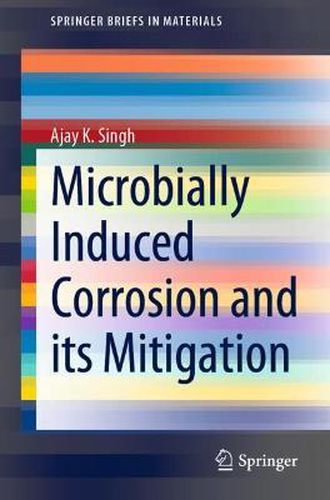Readings Newsletter
Become a Readings Member to make your shopping experience even easier.
Sign in or sign up for free!
You’re not far away from qualifying for FREE standard shipping within Australia
You’ve qualified for FREE standard shipping within Australia
The cart is loading…






This title is printed to order. This book may have been self-published. If so, we cannot guarantee the quality of the content. In the main most books will have gone through the editing process however some may not. We therefore suggest that you be aware of this before ordering this book. If in doubt check either the author or publisher’s details as we are unable to accept any returns unless they are faulty. Please contact us if you have any questions.
This brief covers case studies on Microbial Induced Corrosion (MIC) and its mitigation. After reviewing the basics of corrosion, it focuses on MIC. MIC is a special type of electrochemical corrosion in which the presence of microbes and bacteria alters the chemistry of liquid media so as to make them more corrosive. These changes are harmful to metallic equipment, processing machinery, marine vessels, etc. in an environment that is host to a wealth of microorganisms. A 2007 US survey estimated corrosion-related damages to cost $276 billion a year, roughly 50% of which are due to MIC. The industries most affected by MIC are power production, oil exploration, transportation and storage, water distribution and more generally all industries involving marine environments. However, means for effectively preventing and controlling MIC are poorly understood. As such, the book’s later chapters address various mechanisms/processes that show promise with regard to MIC mitigation. Lastly, the book discusses the strategies currently being explored to mitigate MIC using green technologies.
$9.00 standard shipping within Australia
FREE standard shipping within Australia for orders over $100.00
Express & International shipping calculated at checkout
This title is printed to order. This book may have been self-published. If so, we cannot guarantee the quality of the content. In the main most books will have gone through the editing process however some may not. We therefore suggest that you be aware of this before ordering this book. If in doubt check either the author or publisher’s details as we are unable to accept any returns unless they are faulty. Please contact us if you have any questions.
This brief covers case studies on Microbial Induced Corrosion (MIC) and its mitigation. After reviewing the basics of corrosion, it focuses on MIC. MIC is a special type of electrochemical corrosion in which the presence of microbes and bacteria alters the chemistry of liquid media so as to make them more corrosive. These changes are harmful to metallic equipment, processing machinery, marine vessels, etc. in an environment that is host to a wealth of microorganisms. A 2007 US survey estimated corrosion-related damages to cost $276 billion a year, roughly 50% of which are due to MIC. The industries most affected by MIC are power production, oil exploration, transportation and storage, water distribution and more generally all industries involving marine environments. However, means for effectively preventing and controlling MIC are poorly understood. As such, the book’s later chapters address various mechanisms/processes that show promise with regard to MIC mitigation. Lastly, the book discusses the strategies currently being explored to mitigate MIC using green technologies.